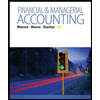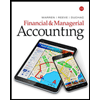
Concept explainers
Problem 22-4B Manufacturing: Preparation of a complete
The management of Nabar Manufacturing prepared the following estimated
Assets Liabilities and Equity
Cash.............................. $ 40,000 Accounts payable................... $ 51,400
Raw materials inventory.............. 35,000 Short-term notes payable ............ 24,000
Finished goods inventory............. 241,080 Total current liabilities ............... 85,400
Total current assets.................. 565,980 Long-term note payable.............. 300,000
Equipment......................... 720,000 Total liabilities...................... 385,400
Equipment.net...................... 430,000
Total
Total assets......................... $1,045,980 Total liabilities and equity ............ $1,045,980
To prepare a master budget for July, August, and September of 2019. Management gathers the following information:
3. Sales were 20,000 units in June.
b. Company policy calls for a given month's ending finished goods inventory to equal 70% of the next month's expected unit sales. The June 30 finished goods inventory is 16,800 units, which does not comply with the policy.
C. Company policy calls for a given month's ending raw materials inventory to equal 20% of the next month's materials requirements. The June 30 raw materials inventory is 4,375 units (which also fails to meet the policy). The budgeted September 30 raw materials inventory is 1,980 units. Raw materials cost $8 per unit. Each finished unit requires 0.50 units of raw materials.
d. Each finished unit requires 0.50 hours of direct labor at a rate of $16 per hour. e.
$20,000 per month is treated as fixed factory overhead. f. Monthly general and administrative expenses include $9,000 administrative salaries and 0.9% monthly interest on the long-term note payable. g. Sales representatives commissions are 10% of sales and are paid in the month of the sales. The sales manager's monthly salary is $3,500.
h. The company expects 30% of sales to be for cash and the remaining 70% on credit. Receivables are collected in full in the month following the sale (none are collected in the month of the sale).
i. All raw materials purchases are on credit, and no payables arise from any other transactions. One month's raw materials purchases are fully paid in the next month.
j. Dividends of $20,000 are to be declared and paid in August.
k. Income taxes payable at June 30 will be paid in July. Income tax expense will be assessed at 35% in the quarter and paid in October.
l. Equipment purchases of $100,000 are budgeted for the last day of September.
m. The minimum ending cash balance for all months is $40,000. If necessary, the company borrows enough cash using a short-term note to reach the minimum. Short-term notes require an interest payment of 1% at each month-end (before any repayment). If the ending cash balance exceeds the minimum, the excess will be applied to repaying the short-term notes payable balance.
Want to see the full answer?
Check out a sample textbook solution
Chapter 22 Solutions
FUND.ACCT.PRIN.(LOOSELEAF)-W/CONNECT
- Please provide the solution to this general accounting question using proper accounting principles.arrow_forwardCan you solve this general accounting question with the appropriate accounting analysis techniques?arrow_forwardPlease explain the solution to this general accounting problem with accurate explanations.arrow_forward
- I need assistance with this financial accounting question using appropriate principles.arrow_forwardWhat is variable cost per unit?arrow_forwardDunlop Systems applies manufacturing overhead to products based on standard machine-hours. The budgeted fixed manufacturing overhead cost for the most recent month was $28,800, and the actual fixed manufacturing overhead cost for the month was $29,320. The company based its original budget on 7,200 machine-hours. The standard hours allowed for the actual output of the month totaled 6,800 machine-hours. a. What was the overall fixed manufacturing overhead budget variance for the month? b. What was the fixed overhead rate? c. What was the volume variance?arrow_forward
- I need help with this general accounting problem using proper accounting guidelines.arrow_forwardI am looking for the correct answer to this general accounting question with appropriate explanations.arrow_forwardI need help finding the accurate solution to this general accounting problem with valid methods.arrow_forward
- I am looking for the correct answer to this general accounting problem using valid accounting standards.arrow_forwardCan you help me solve this financial accounting question using the correct financial procedures?arrow_forwardI need assistance with this general accounting question using appropriate principles.arrow_forward
 Financial & Managerial AccountingAccountingISBN:9781285866307Author:Carl Warren, James M. Reeve, Jonathan DuchacPublisher:Cengage Learning
Financial & Managerial AccountingAccountingISBN:9781285866307Author:Carl Warren, James M. Reeve, Jonathan DuchacPublisher:Cengage Learning Financial & Managerial AccountingAccountingISBN:9781337119207Author:Carl Warren, James M. Reeve, Jonathan DuchacPublisher:Cengage Learning
Financial & Managerial AccountingAccountingISBN:9781337119207Author:Carl Warren, James M. Reeve, Jonathan DuchacPublisher:Cengage Learning


